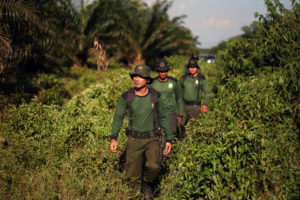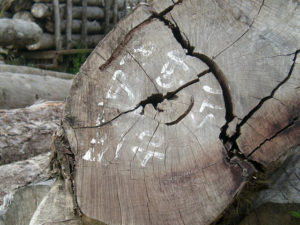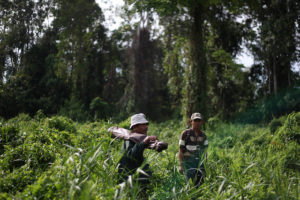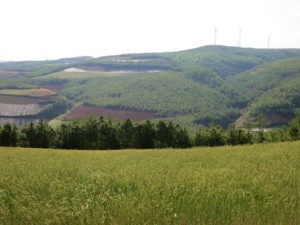
Study gives new insights into carbon monitoring methods at the local level.
Forests play a central role in climate change mitigation, as recognized by the Paris Agreement. Over the last decade, hundreds of subnational initiatives to reduce emissions from deforestation and forest degradation (REDD+) have flourished worldwide, and numerous countries mention either forests or REDD+ as part of their mitigation strategies.
Yet, very little is known about the carbon effectiveness of these initiatives.
“There is a lot of attention on how to implement REDD+ at the national and international level, especially with respect to designing financial frameworks and measuring the global tree cover change,” explains Astrid Bos. “What is not so clear is how to measure the impact of specific initiatives on the ground.”
This prompted Bos — who is the lead author of a new study, alongside senior scientist Amy Duchelle and other researchers and partners of the Center for International Forestry Research (CIFOR) — to explore the comparative potential of two methods for assessing the effectiveness of subnational REDD+ initiatives.
The ‘BA approach’ analyzes tree cover in a given area before and after a REDD+ intervention. The ‘BACI approach’ is a more complex, costly method that includes control areas — very similar to initiative areas, but not subjected to interventions. Both were tested at the village and at the site level — encompassing districts, regions and even biomes.
The assessment methods were put to the test on 23 subnational initiatives from CIFOR’s Global Comparative Study (GCS) on REDD+ in Brazil, Peru, Cameroon, Tanzania, Indonesia and Vietnam. The results were revealing.
Read also: Smallholder farmers in REDD+ sites: The cost of missed opportunities

SCALE MATTERS
The before-after method seems straightforward enough: increases in tree cover loss mean failure of the REDD+ intervention. Or do they? What the BA approach fails to take into account is the background noise affecting tree cover.
This may range from periods of extreme drought and spontaneous fires, to newly constructed roads and global commodity prices — factors beyond the scope of REDD+ initiatives.
“With the before-after approach, these background dynamics can be very misleading,” notes Bos, who is a PhD candidate at the Wageningen University Laboratory of Geo-information Science and Remote Sensing. “This is why we argue you have to put the observed changes in tree cover into context, so that you are comparing apples with apples.” This is precisely the strength of BACI.
Because, in theory, both the control and the intervention areas are subject to the same time-varying factors — including socioeconomic ones — any difference in tree cover between them should be able to be attributed to REDD+ interventions.
However, BACI comes with its own set of challenges, the main one being the fact that results are only as good as the choice of control areas. “The bigger the surface, the more difficult it is to find a control area that has the same characteristics as the intervention one,” says Bos. And the area in question may be as big as a Brazilian state.

The first conclusion of the study is that the BACI approach is more relevant the more local the scale of the assessment is. “Using BACI at village rather than at initiative level, besides being much easier, is more accurate,” sums up the researcher. “Comparing areas at higher levels turned out to be more difficult than we expected.”
At the onset of the GCS REDD+, control areas were selected based on reported forest cover loss from cost- and labor-intensive field studies. Now, new global forest datasets based on satellite data allow for improved control area selection. “This is a very good moment to start implementing the BACI approach at the local scale,” concludes Bos.
DIRECTION OF CHANGE
A second conclusion is that the before-after approach, which focuses on the direction of change, is also useful under certain conditions. In some cases, the BA scores flag poor and BACI scores good performance of a particular REDD+ initiative. So, which one is right?
When increases in deforestation are higher in control areas than in intervention ones, the BA score makes clear that deforestation is still increasing, just less rapidly than would have occurred without REDD+.
“Conversely, in situations of generalized positive changes, BA scores alone risk painting a rosier picture than could be reasonably attributed to the REDD+ intervention,” adds the paper.
Independent of approach, the study found a slightly better performance at the village level that at the initiative one. According to Bos, one of the reasons could be related to the so-called ‘treatment density’, meaning that “REDD+ initiatives, especially if the proponent is an NGO, may not be targeting all the villages inside the initiative boundary.”
Although the study focused on analyzing monitoring approaches, it notes the “overall minimal impact of REDD+ in reducing deforestation so far,” regardless of the method used to assess the effectiveness of the initiatives.
“This could be the subject of another study,” says Bos, but she offers some possible explanations: slow implementation of interventions, and proponents that target smallholders instead of the main drivers of deforestation at their sites are two of them.
Other reasons may have to do with the design of the research project itself. The study focuses on deforestation, without analyzing degradation or reforestation, and it does not examine specific REDD+ intervention strategies used at different sites.
THE WAY FORWARD
A next research step is to link performance assessment results to intervention mixes, and to monitor effectiveness of REDD+ initiatives over a longer timeframe, which Duchelle notes is now in progress as part of the third phase of GCS REDD+. Interventions may include varying combinations of incentives, such as livelihood improvements; disincentives, such as fees; and enabling measures, such as tenure clarification.
“It is crucial to link tree cover change to particular REDD+ strategies; what works in one area might not be the solution in another one,” stresses Bos. Better understanding what works in which contexts may also provide valuable pointers for upscaling options to national REDD+ policies.
Countries, the study argues, should find ways to incorporate results from local level monitoring into their national reporting systems. “After all, overall REDD+ impact depends on land-use decisions on the ground.”
By Gloria Pallares, originally published at CIFOR’s Forests News.
For more information on this topic, please contact Amy Duchelle at a.duchelle@cgiar.org.
This research forms part of the CGIAR Research Program on Forests, Trees and Agroforestry, which is supported by CGIAR Fund Donors.
This research was supported by the Norwegian Agency for Development Cooperation (Norad), the International Climate Initiative (IKI) of the German Federal Ministry for the Enviroment, Nature Conservation, Building and Nuclear Safety (BMUB), the UK Department for International Development (UKAID), the Australian Department of Foreign Affairs and Trade (DFAT), and the European Union.













